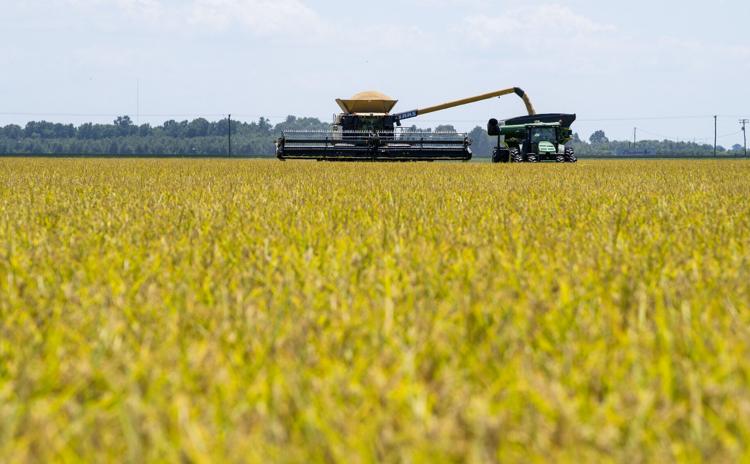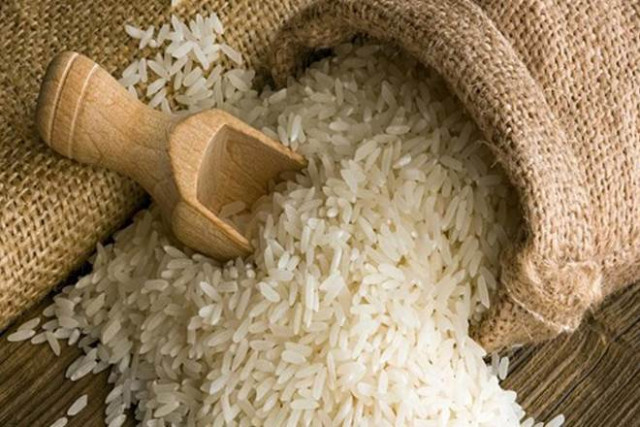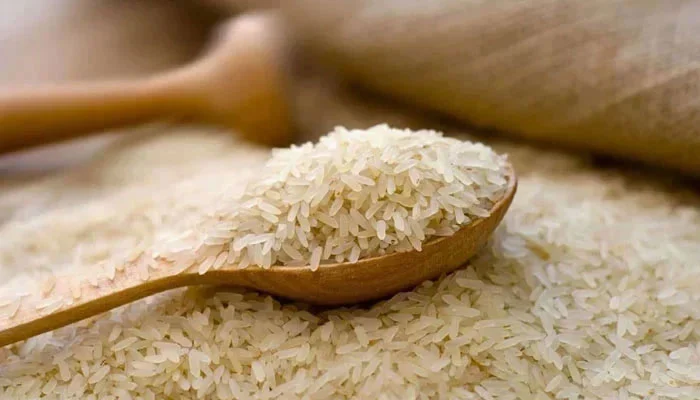Tags
Study: 1 percent increase in unbroken rice could help feed millions more, boost producer profit

File photo of rice being harvested in 2020 at a farm in Arkansas County near Stuttgart.U of A System Division of Agriculture
A 1 percent increase in unbroken rice kernels after milling could mean millions more servings of this critical staple grain, increased food security around the globe and improved producer profitability, a study from two Arkansas researchers suggests.
Professor Lanier Nalley and Associate Professor Alvaro Durand-Morat, both in the agricultural economics and agribusiness department, conduct research for the Arkansas Agricultural Experiment Station, the research arm of the Division of Agriculture, and teach in the Dale Bumpers College of Agricultural, Food and Life Sciences at the University of Arkansas.
Their study estimated the impact of improving rice milling yields using harvest data from 2004 to 2020. Their aim was to understand the food security implications of milling quality.
With a 1 percent increase in unbroken rice kernels after milling, Nalley and Durand-Morat calculated that Arkansas, the nation’s top rice-growing state, could hypothetically produce up to 0.89-1.05 million more servings of rice annually without increasing yield or production inputs. In another scenario, they estimate Arkansas could produce up to 3.5 million more servings annually if all rice grown was set to a minimum benchmark milling yield potential based on a popular purebred University of Arkansas System Division of Agriculture variety.
When it comes to rice breeding, “everyone wants quantity, but quality is also important,” Nalley said. In terms of this study, “quality” means rice grains that resist breaking during the milling process.
“Improving rice quality by reducing the amount of broken rice will result in more rice reaching consumers rather than being used for other non-food uses,” Nalley said. “If we can improve genetics for quality, we’re getting more and more rice going to humans.”
Calculations of milling yield include the “head rice” yield, which is the percentage of whole kernels over the total whole and broken milled kernels. When rice is harvested from the field, the rice grains are encased in an inedible hull and covered by a bran layer, Nalley said. Milling removes the hull and bran layer to reveal the white rice grain. Milling yield is the percentage of polished white rice obtained from milling the rice harvested directly from the field.
With this study, the researchers wanted to measure the economic impact of rice quality. To do this, they simulated the increase of the number of whole milled kernels rather than raising the yield ceiling by increasing paddy yield, which is the number of freshly harvested rice grains.
FROM PADDY TO PLATE
According to the 2023 Arkansas Agriculture Profile, Arkansas was the top rice-producing state in the United States in 2022. U.S. Department of Agriculture data shows that Arkansas accounted for nearly 50 percent of U.S. rice production last year.
Arkansas rice feeds people living in some of the poorest countries in the Western Hemisphere, such as Haiti, which is the largest importer of Arkansas rice, Nalley said.
Haiti has one of the highest quality standards of rice in the Western hemisphere, a maximum of 4 percent broken kernels for imported rice, according to another study done in collaboration with Nalley.
The commercial quality benchmark for rice produced in the United States is 21.4 percent broken kernels. The average of the Arkansas-grown varieties from the study’s selected years was 16.5 percent.
WHY RICE BREAKS
Rice breaks during milling for many reasons, such as environmental and weather-related or genetic causes, Nalley said. He said his research focused on how growing higher-quality rice could feed more people worldwide and improve the bottom line for Arkansas producers.
Producers profit from rice based on how much they yield and the number of whole kernels after milling, Nalley said. Broken kernels receive a discounted price, from 50 to 72 percent of the value of whole kernels. Broken kernels also end up in alternative markets, such as the pet food and beer brewing industries. The markets that accept broken kernels for human consumption, such as some West African nations, are quickly saturated, Nalley added.
“Increasing quality will increase producer profitability, and it gets rice into some of the poorest people’s stomachs in the world,” Nalley said.
NOT MAGIC, MATHEMATICS
To illustrate the possibilities of increased rice milling yields due to improved rice genetics, Nalley and Durand-Morat considered two theoretical scenarios: the 1 percent marginal increase in head rice yield that resulted in up to 1.05 million more rice servings, and a scenario based on setting a minimum milling yield potential. The researchers selected Roy J, a purebred Arkansas rice variety developed by Karen Moldenhauer, professor and rice breeder emeritus, as the minimum milling standard.
Using Arkansas rice acreage data from 2004-2020, along with yearly variety-specific yield and milling rates from the Arkansas Rice Performance Trials, Nalley calculated the hypothetical increase in head rice yield for each variety harvested in Arkansas.
For example, the head rice yield of Roy J in 2015 was 61 percent. The researchers artificially set 61 percent as the minimum head rice yield for all varieties grown in Arkansas in 2015 and calculated the resulting increase in milling yield for that year. The researchers input the hypothetical milling yield values from 2004-2020 into a model that assessed the cumulative impact of the increased head rice on the market.
They found that setting a minimum milling yield to match Roy J could increase the number of rice rations produced in Arkansas between 2.94 and 3.5 million annually. This corresponds to an average of $24.48 million in potential annual economic value added to the state.
The researchers selected Roy J as the baseline milling yield variety because it is a pure line — meaning rice breeding programs do not need hybrid breeding capabilities — and because it was not the top milling variety, which makes the scenario more attainable.
RICE BREEDING FOCUS
High-yielding rice varieties are popular with producers, Nalley said, but this research shows the potential benefits of also breeding for improved milling quality.
“The golden goose is to increase yield,” Nalley said. “Ideally, you would increase yield and simultaneously increase quality, but that’s like patting your head and rubbing your stomach at the same time — it’s hard to do.”
Nalley said the experiment station’s rice breeders have done a great job of putting an emphasis on quality as well as yield.
Xueyan Sha, professor of rice breeding and genetics for the experiment station, said that the rice breeding program focuses on yield, but also milling and grain quality, disease resistance and lodging tolerance to “improve the bottom line, meet end-user demand and improve sustainability.”
Sha said the rice breeding program improves genetics by using and developing strong parent rice lines and making rigorous selections at all stages of rice breeding.
Though he and Durand-Morat set the equations to demonstrate the importance of rice milling quality, Nalley recognizes the work of the rice breeding program.
“I want to see people be fed, and I want to see Arkansas producers be profitable,” Nalley said. “I think this is one of the ways to do that, and I think the rice breeding leaders at the Division of Agriculture have done a very good job of not sacrificing quality for quantity.”
“All we’re doing is telling their story,” he said.
Nalley and Durand-Morat’s research article was published in the Journal of Agricultural and Resource Economics, “Feeding More with the Same Output: How Enhanced Rice Quality Genetics Can Lead to Increased Food Security and Producer Profitability.”
https://www.magnoliareporter.com/news_and_business/local_business/article_b503aed8-5b60-11ee-93e0-7f5a434877a5.htmlPublished Date: January 1, 2024





